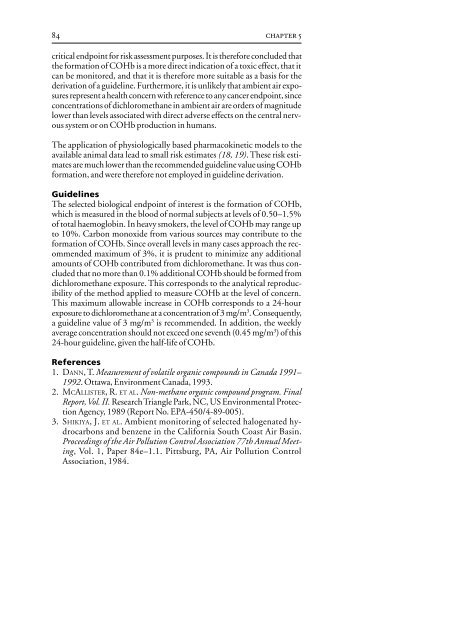Air Quality Guidelines - World Health Organization Regional Office ...
Air Quality Guidelines - World Health Organization Regional Office ...
Air Quality Guidelines - World Health Organization Regional Office ...
You also want an ePaper? Increase the reach of your titles
YUMPU automatically turns print PDFs into web optimized ePapers that Google loves.
84 chapter 5<br />
critical endpoint for risk assessment purposes. It is therefore concluded that<br />
the formation of COHb is a more direct indication of a toxic effect, that it<br />
can be monitored, and that it is therefore more suitable as a basis for the<br />
derivation of a guideline. Furthermore, it is unlikely that ambient air exposures<br />
represent a health concern with reference to any cancer endpoint, since<br />
concentrations of dichloromethane in ambient air are orders of magnitude<br />
lower than levels associated with direct adverse effects on the central nervous<br />
system or on COHb production in humans.<br />
The application of physiologically based pharmacokinetic models to the<br />
available animal data lead to small risk estimates (18, 19). These risk estimates<br />
are much lower than the recommended guideline value using COHb<br />
formation, and were therefore not employed in guideline derivation.<br />
<strong>Guidelines</strong><br />
The selected biological endpoint of interest is the formation of COHb,<br />
which is measured in the blood of normal subjects at levels of 0.50–1.5%<br />
of total haemoglobin. In heavy smokers, the level of COHb may range up<br />
to 10%. Carbon monoxide from various sources may contribute to the<br />
formation of COHb. Since overall levels in many cases approach the recommended<br />
maximum of 3%, it is prudent to minimize any additional<br />
amounts of COHb contributed from dichloromethane. It was thus concluded<br />
that no more than 0.1% additional COHb should be formed from<br />
dichloromethane exposure. This corresponds to the analytical reproducibility<br />
of the method applied to measure COHb at the level of concern.<br />
This maximum allowable increase in COHb corresponds to a 24-hour<br />
exposure to dichloromethane at a concentration of 3 mg/m 3 . Consequently,<br />
a guideline value of 3 mg/m 3 is recommended. In addition, the weekly<br />
average concentration should not exceed one seventh (0.45 mg/m 3 ) of this<br />
24-hour guideline, given the half-life of COHb.<br />
References<br />
1. DANN, T. Measurement of volatile organic compounds in Canada 1991–<br />
1992. Ottawa, Environment Canada, 1993.<br />
2. MCALLISTER, R. ET AL. Non-methane organic compound program. Final<br />
Report, Vol. II. Research Triangle Park, NC, US Environmental Protection<br />
Agency, 1989 (Report No. EPA-450/4-89-005).<br />
3. SHIKIYA, J. ET AL. Ambient monitoring of selected halogenated hydrocarbons<br />
and benzene in the California South Coast <strong>Air</strong> Basin.<br />
Proceedings of the <strong>Air</strong> Pollution Control Association 77th Annual Meeting,<br />
Vol. 1, Paper 84e–1.1. Pittsburg, PA, <strong>Air</strong> Pollution Control<br />
Association, 1984.

















